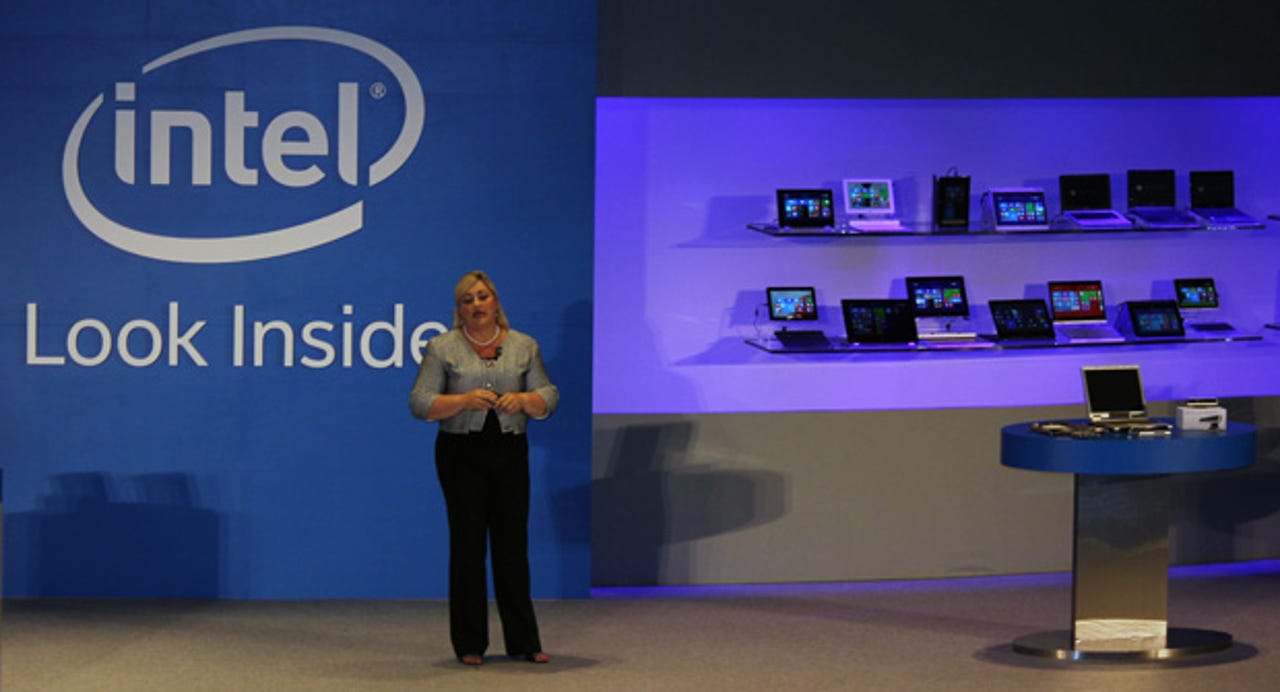Computex 2014: Intel says Moore's Law will drive the next era in computing


Each year at Computex, Intel uses the opening keynote to give a pep talk to its partners in Taiwan that design and build the world’s laptops and desktops. This year the company was forced to do even more cheerleading than usual.
The headline is that Intel announced the industry’s first 14nm processor family, but the reality is that Broadwell is late and won’t be available until the holidays. Furthermore Intel’s current mobile chipsets are not cost-competitive, forcing it to subsidize tablets until new processors arrive in early 2015.
Despite these setbacks, Intel President Renee James said that Moore’s Law will continue to drive innovation and revive a sluggish PC market. Noting that the PC had been left for dead many times over in the past, she urged partners in Taiwan to continue developing new x86 devices such as smartphones, tablets and 2-in-1s.
“Whenever the headlines predict that we’ve come as far as possible, that we’ve reached the endpoint, our industry has proven time and time again that it isn’t true,” James said. “Our industry continues to reinvent itself.”
Here’s what we do now know about Broadwell. The first chips in the next Core line will be low-power ones designed for thin, fanless laptops and 2-in-1s and will be known by the designation Core M. This will include the Core-M70 and the Core-M vPro for businesses. Intel already has a low-power Core line, known internally as the Haswell Y series, but James said the Broadwell version will deliver higher performance and lower power (“well under 10 watts”), and have a smaller footprint.
To illustrate the kinds of devices that will be enabled by the Core M, James showed a reference design for a 12.5-inch tablet, code-named Llama Mountain, that is only 0.28 inches thick and weighs 1.48 pounds without the detachable keyboard. In comparison, the Samsung Galaxy Tab Pro, with a 12.2-inch display, measures 0.31 inches and weighs 1.63 pounds. Asus Chairman Jonney Shih also came onstage to talk about the company’s new product announcements including the Transformer Book T300 Chi, a very thin detachable with a 12.5-inch WQHD display (2,560 by 1,440 pixels) that will be among the first to use the Core M chip.
Intel will hold a separate press event on Wednesday to talk about both the Core family for PCs and Atom for mobile, so I’m hoping that we will hear more about Broadwell there.
As far as mobile goes, Intel said that 130 Intel-based tablets, running Android or Windows, will be launched this year--including 12 announced at this year’s Computex. Most of these will use the current Bay Trail SoC or the newer Merrifield dual-core and Moorefield quad-core chips announced at Mobile World Congress. James said that Intel was on track to ship 40 million tablets this year. Intel showed some demonstrations of how a Bay Trail tablet and Moorefield smartphone stack up against Qualcomm’s Snapdragon 801 (favorably, of course) in gaming, photo editing and mobile benchmarks.
To get into lower-priced smartphones and tablets, Intel plans to release a new mobile family, known as SoFIA starting later this year. These chips, which stem from the Infineon acquisition and are actually manufactured by foundry TSMC, will include a dual-core with integrated 3G shipping by the end of this year and a quad-core with on-die 4G LTE, shipping in the first half of 2015. Last week, as part of a deal with China’s Rockchip, Intel added a quad-core version with 3G to next year’s roadmap as well. During the keynote, James made what she said was the first “live call” on a SoFIA-based smartphone using Chunghwa Telecom’s network. She also talked on Intel’s progress on LTE and said the company has completed solutions with LTE-Advanced Category-6 and features such as carrier aggregation.
At the opposite end of the spectrum, Intel officially launched the previously-announced Devil’s Canyon and Anniversary Edition Pentium processors for enthusiasts. Devil’s Canyon is an updated version of the unlocked Haswell K series, and includes the 3.5GHz Core i5-4690K (four cores and four thread) and Core i7-4790K (four cores, eight threads), which Intel says is the world’s first consumer quad-core capable of running all four cores at a base frequency of 4GHz. In Turbo Mode, the cores can burst as high as 4.4GHz, and James said Devil’s Canyon also leaves plenty of headroom for overclocking. The Pentium G3258 is a 3.2GHz dual-core that is also overclockable. Intel also announced a new family of PCI Express solid-state drives, which support the NVM Express storage protocol, for higher performance and lower latency.
James said that ultimately computing will be about a continuum of connected devices, rather than one form factor or device. This era of integrated computing will continue to be driven by semiconductors and Moore’s Law. “Today we have 14m and we can see our way to 10nm,” James said. Intel is betting that this technology will be important not just in PCs, but in all markets from tiny sensors to the servers that power massive cloud data centers.